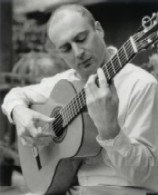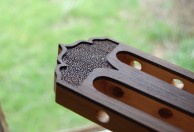Welcome to one of the most active flamenco sites on the Internet. Guests can read most posts but if you want to participate click here to register.
This site is dedicated to the memory of Paco de Lucía, Ron Mitchell, Guy Williams, Linda Elvira, Philip John Lee, Craig Eros, Ben Woods, David Serva and Tom Blackshear who went ahead of us.
We receive 12,200 visitors a month from 200 countries and 1.7 million page impressions a year. To advertise on this site please contact us.
|

|
|
RE: Questions about braces
|
You are logged in as Guest
|
|
Users viewing this topic: none
|
|
Login  | |
|

   
Cervantes
Posts: 503
Joined: Jun. 14 2014
From: Encinitas, CA USA

|
 RE: Questions about braces (in reply to Andy Culpepper) RE: Questions about braces (in reply to Andy Culpepper)
|
|
|
quote:
ORIGINAL: Andy Culpepper
The most important thing to understand about guitar making, IMO, is that a guitar is a holistic system, not just a bunch of individual parts or attributes.
It's easy to look at the bracing pattern and think that's where the magic is. It's easy to look at the air resonance and think that's what makes a good guitar, until you get proven otherwise.
If great guitars were the result of making easy, formulaic choices, then making great guitars would be easy, which it's not.
You can't understand fan bracing until you look at the bridge and the harmonic bars.
You can't understand the bridge and the harmonic bars until you look at the top doming and thickness.
You can't understand the top doming and thickness until you look at the back doming and thickness.
etc. etc.
So where do you start to begin to understand these things without any experience building and not going through a lot of trial and error?
_____________________________
Ah well, there was a fantastic passion there, in my case anyway. I discovered flamenco
very early on. It grips you in a way that you can't get away - Paco Pena
|
|
|
|
REPORT THIS POST AS INAPPROPRIATE |
Date Jul. 19 2017 21:28:03
 |
|

   
Andy Culpepper
Posts: 3023
Joined: Mar. 30 2009
From: NY, USA

|
 RE: Questions about braces (in reply to constructordeguitarras) RE: Questions about braces (in reply to constructordeguitarras)
|
|
|
Thanks John. Also your comment earlier about the pointed brace shape giving maximum stiffness to weight is well taken, although it's interesting how some builders have opted for rounded tops.
quote:
So where do you start to begin to understand these things without any experience building and not going through a lot of trial and error?
Honestly, you can pick up a lot of information by reading and asking questions, but I don't know if you can ever fully understand the relevance of that information without putting things into practice for yourself.
When you're making guitars, each one is different and its own animal in some way. Different woods, different player preferences, etc. and you have to have a tremendous bag of tricks that you can pull out at different times in order to push that guitar into its "sweet spot". I believe that with every set of wood and acoustic parameters, there is an optimal way to build that into the guitar that you want. It's like focusing a camera. There is ONE exact spot where the object you're shooting is perfectly in focus.
The difference is that with guitar making you don't have immediate feedback on the focus and you can't compare it to what it could have been. So it's easy to let it get a little bit fuzzy and never even know that it could have been better if you had done something slightly differently. You left the back a little too thick, the bridge a little too light for the top, etc. so the sound you wanted is slightly out of focus, although somebody else might like the guitar just fine but it's all about what you are shooting for.
And it's really, really hard because there are a million variables. But I think that knowing how to treat each guitar as a unique entity, and how to adjust your approach to each piece of wood that goes into that guitar to bring them together as a whole, is what separates out the best builders.
_____________________________
Andy Culpepper, luthier
http://www.andyculpepper.com
|
|
|
|
REPORT THIS POST AS INAPPROPRIATE |
Date Jul. 19 2017 23:54:39
 |
|
 New Messages New Messages |
 No New Messages No New Messages |
 Hot Topic w/ New Messages Hot Topic w/ New Messages |
 Hot Topic w/o New Messages Hot Topic w/o New Messages |
 Locked w/ New Messages Locked w/ New Messages |
 Locked w/o New Messages Locked w/o New Messages |
|
 Post New Thread
Post New Thread
 Reply to Message
Reply to Message
 Post New Poll
Post New Poll
 Submit Vote
Submit Vote
 Delete My Own Post
Delete My Own Post
 Delete My Own Thread
Delete My Own Thread
 Rate Posts
Rate Posts
|
|
|
Forum Software powered by ASP Playground Advanced Edition 2.0.5
Copyright © 2000 - 2003 ASPPlayground.NET |
0.125 secs.
|


 Printable Version
Printable Version












 New Messages
New Messages No New Messages
No New Messages Hot Topic w/ New Messages
Hot Topic w/ New Messages Hot Topic w/o New Messages
Hot Topic w/o New Messages Locked w/ New Messages
Locked w/ New Messages Locked w/o New Messages
Locked w/o New Messages Post New Thread
Post New Thread